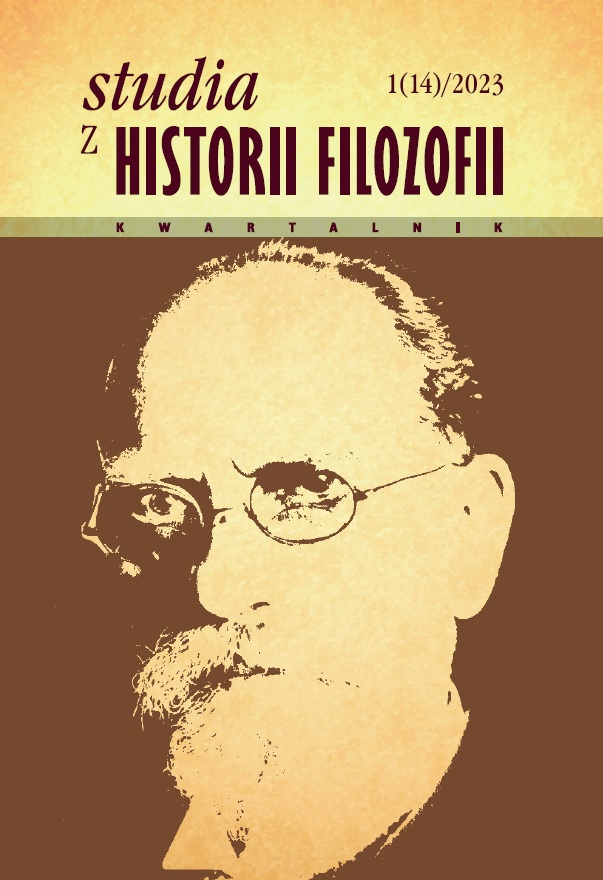Konceptualizm Richarda Burthogge’a i jego źródła w średniowiecznej optyce perspektywistycznej
DOI:
https://doi.org/10.12775/szhf.2023.002Słowa kluczowe
Richard Burthogge, średniowieczny perspektywizm, optyka, konceptualizm, idealizmAbstrakt
Artykuł poświęcony jest analizie historycznych uwarunkowań konceptualistycznego argumentu na rzecz idealizmu epistemologicznego, sformułowanego przez siedemnastowiecznego filozofa angielskiego Richarda Burthogge’a. Istotą tego argumentu, niemającego precedensu we wcześniejszej filozofii, jest próba dowiedzenia tezy o immanentnej nieadekwatności ludzkiego poznania na podstawie dysproporcji pomiędzy ogólnością pojęcia a jednostkowością rzeczy pozaumysłowych. Jednocześnie, relację między powszechnikiem a konkretem uznaje Burthogge za analogiczną do relacji między obrazem wizualnym a rzeczą. Celem artykułu jest wykazanie, że decydujący wpływ na koncepcję poznania wzrokowego, która dostarczyła podłoża dla tej analogii, a co za tym idzie dla argumentu konceptualistycznego, wywarła średniowieczna optyka perspektywistyczna.
Bibliografia
Darrigol Oliver. 2012. A History of Optics. From Greek Antiquity to the Nineteenth Century. Oxford: Oxford University Press.
Denery Dallas G. II. 2005. Seeing and Being Seen in the Later Medieval World. Optics, Theology and Religious Life. Cambridge: Cambridge University Press.
Doesschate Gezienus ten. 1962. „Oxford and the Revival of Optics in the Thirteenth Century”. Vision Research 1(5–6): 313–342.
Fornasieri Giacomo. 2021. „Conception, Connotation, and Essential Predication: Peter Auriol’s Conceptualism to the Test in II Sententiarum, D. 9, Q. 2, Art. 1”. Analiza i Egzystencja 54: 81–126.
Friedman Russell L. 2021. „Peter Auriol”. W: The Stanford Encyclopedia of Philosophy, red. Edward N. Zalta. Summer 2021 Edition. Dostęp 28.06.2022. https://plato.stanford.edu/archives/sum2021/entries/auriol/.
Innes Smith Robert W. 1932. English-Speaking Students of Medicine at the University of Leyden. Edinburgh–London: Oliver and Boyd.
Keele Rondo. 2015. „The Early Reception of Peter Auriol at Oxford. Part I: From Ockham to the Black Death”. Recherches de théologie et philosophie médiévales 82(2): 301–361.
Kierul Jerzy. 2007. Kepler. Warszawa: Państwowy Instytut Wydawniczy.
Lička Lukáš. 2016. „Perception and Objective Being: Peter Auriol on Perceptual Acts and their Objects”. American Catholic Philosophical Quarterly 90(1): 49–76.
Lindberg David C. 1976. Theories of Vision from Al-Kindi to Kepler. Chicago–London: The University of Chicago Press.
Lovejoy Arthur O. 1908. „Kant and the English Platonists”. W: Essays Philosophical and Psychological in Honor of William James, Professor in Harvard University, 265–302. New York: Longmans, Green, and Co.
McCracken Charles J. 1983. Malebranche and British Philosophy. Oxford: Clarendon Press.
McEvoy James. 1986. The Philosophy of Robert Grosseteste. Oxford: Clarendon Press.
Nolan Edward P. 1990. Now Through a Glass Darkly. Specular Images of Being and Knowing from Vergil to Chaucer. Ann Arbor: The University of Michigan Press.
Pasnau Robert. 1997. Theories of Cognition in the Later Middle Ages. Cambridge: Cambridge University Press.
Smith A. Mark. 2004. „What Is the History of Medieval Optics Really About?”. Proceedings of the American Philosophical Society 148(2): 180–194.
Smith A. Mark. 2015. From Sight to Light. The Passage from Ancient to Modern Optics. Chicago–London: The University of Chicago Press.
Swieżawski Stefan. 2012. Dzieje europejskiej filozofii klasycznej. Warszawa: Wydawnictwo Naukowe PWN.
Tachau Katherine H. 1988. Vision and Certitude in the Age of Ockham. Optics, Epistemology and the Foundations of Semantics 1250–1345. Leiden: E.J. Brill.
Wood Anthony A., Philip Bliss (red.). 1820. Athenae Oxonienses, t. 4. London: Thomas Davison, Whitefriars.
Żukowski Bartosz. 2019. Niezauważona rewolucja. Konstruktywistyczny idealizm Richarda Burthogge’a. Łódź: Wydawnictwo Uniwersytetu Łódzkiego.
Pobrania
Opublikowane
Jak cytować
Numer
Dział
Licencja

Utwór dostępny jest na licencji Creative Commons Uznanie autorstwa – Bez utworów zależnych 4.0 Międzynarodowe.
Statystyki
Liczba wyświetleń i pobrań: 553
Liczba cytowań: 0



